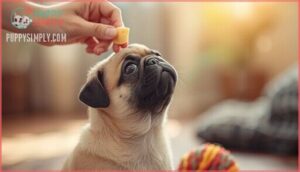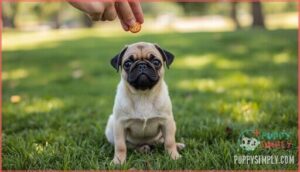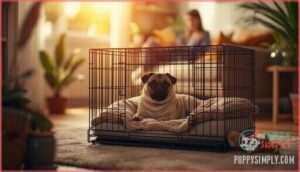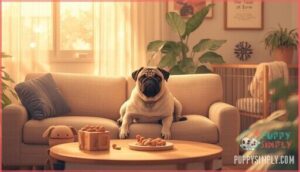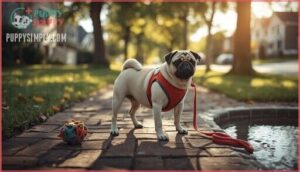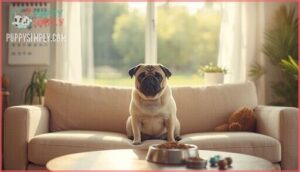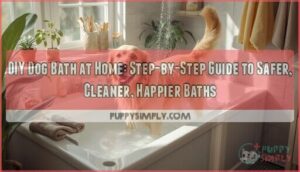This site is supported by our readers. We may earn a commission, at no cost to you, if you purchase through links.

Pugs have strong opinions and sometimes a stubborn streak, which can make training feel like a puzzle. With the right mix of encouragement, timing, and a few clever tricks, even the quirkiest pug can surprise you.
Understanding what makes pugs tick transforms ordinary efforts into real progress, unlocking a new side of your dog and deepening the bond you share.
Table Of Contents
- Key Takeaways
- Establishing Leadership
- Teaching Focus and Attention
- Basic Obedience Training
- Housebreaking a Pug
- Crate Training for Pugs
- Managing Separation Anxiety
- Activity and Exercise Needs
- Preventing Problem Behaviors
- Training Older Pugs
- Committing to Your Pug
- Frequently Asked Questions (FAQs)
- How do you train a pug if he has a short attention span?
- Are Pugs hard to train?
- How to train a pug?
- Do Pugs need to be potty trained?
- Do Pugs like Crate training?
- Can Pugs learn things faster?
- How long do training sessions need to be for an adult pug?
- What should I do if my pug is fearful or anxious during training?
- How can I train my pug if I have mobility issues or disabilities?
- Are there any special considerations for training an overweight or obese pug?
- Conclusion
Key Takeaways
- Pugs can be stubborn, but respond best to gentle, consistent routines using positive reinforcement.
- Short, focused training sessions with high-value treats and praise help pugs learn despite short attention spans.
- Early socialization and regular routines prevent problem behaviors and help pugs feel confident and secure.
- Patience and a steady approach are key, since building trust and communication takes time with this playful breed.
Establishing Leadership
Trust forms the foundation of every successful pug training journey. When you establish yourself as a calm, confident leader, your pug feels secure and ready to learn.
Forget the outdated alpha dominance myths. Modern canine behavior research shows that positive guidance works far better than force. Your pug reacts to clear communication and owner consistency, not intimidation. Dogs whose owners display consistent leadership show up to 40% higher obedience scores across standardized command tasks. Many experts now consider dominance theory outdated.
Building trust starts with routine benefits. Set regular feeding times, bathroom breaks, and training sessions. This predictability helps your naturally stubborn pug understand what you expect. When you’re consistent with rules—like no jumping on furniture—your pug learns boundaries without confusion.
Remember, pugs can be headstrong, but they’re also willing to please. Use firm but gentle commands. Praise good dog behavior immediately. Your consistency and positive approach will overcome their occasional stubbornness while strengthening your bond.
Teaching Focus and Attention
Once your pug trusts your leadership, teaching focus becomes your next priority. Pugs naturally have short attention spans, but research shows dogs respond 45% better to high-value rewards like cheese during attention tasks.
Here’s how to build laser-sharp focus:
- Start with the “watch me” command – Hold treats near your eyes and reward eye contact
- Use motion stimuli – Moving toys capture attention 20% longer than static objects
- Keep sessions short – Weekly training beats daily sessions for better retention
- Combine visual cueing with gestures – Pointing plus eye contact boosts success rates greatly
Session frequency matters more than duration. Studies with 44 dogs proved once-weekly training produces stronger results than daily sessions. A recent study found that gaze and pointing together are most effective.
Reward systems work best when you pair treats with praise immediately. Motion stimuli like waving toys help maintain focus during training challenges for pugs. Remember, their brachycephalic features mean shorter sessions prevent overheating while building that vital focus command foundation. Your pug’s lifespan attention improves with consistent practice, even as they age.
Basic Obedience Training
Now that your pug knows how to focus on you, it’s time to build their command foundation with basic obedience training. Research shows pugs need 40-80 repetitions to master new commands, but positive reinforcement makes all the difference.
Start with “sit” – it’s the easiest win. Hold a treat above their nose and slowly move it back. Their bottom naturally hits the ground. Say “sit” and reward immediately. Consistency matters more than ideal timing.
Keep training sessions short – just 5-10 minutes work best. Pugs lose focus quickly, and studies prove brief sessions boost retention by 20%. Practice “stay,” “come,” and “down” using the same treat motivation approach.
Your pug’s stubborn streak means patience pays off. They rank 108th in obedience intelligence, but don’t let that discourage you. With consistent daily practice, most pugs master basic commands within weeks. Dog obedience isn’t about flawlessness – it’s about building communication between you and your furry friend.
Housebreaking a Pug
Building on your pug’s command foundation, house training becomes your next priority. Your pug’s small bladder means they need bathroom breaks every 2-3 hours during puppyhood. That’s just how their bodies work.
Success comes down to creating a solid potty schedule and sticking to it. Take them out after meals, naps, and play sessions. When accidents happen – and they’ll – clean up thoroughly to prevent scent marking in the same spot.
Consider these interim solutions while establishing your bathroom routine:
- Puppy pads near the door for emergency elimination
- Paper training as a backup when you can’t get outside quickly
Reward immediately when they go in the right place. Most pugs master house training within three months with consistent positive reinforcement.
Crate Training for Pugs
Beyond your pug’s housebreaking progress, crate training creates a secure den that reinforces both potty training and emotional well-being. Your pug needs a crate that’s at least 18″ x 24″ – big enough to stand, turn around, and lie down comfortably.
Start with gradual crate introduction. Feed meals inside with the door open, then add a “go to crate” command. Keep initial sessions short – about 15 minutes twice daily. Puppies adjust more quickly than older dogs, usually mastering crate training within days to weeks.
Place the crate in your main living area with soft bedding and familiar toys. This prevents isolation stress while building positive associations. Your pug should see their crate as a cozy retreat, not punishment.
Effective methods include feeding inside, using high-value treats, and staying nearby during early training. Most pugs learn to love their crate when you pair it with good things consistently.
Managing Separation Anxiety
After establishing your pug’s crate comfort, addressing separation anxiety becomes your next priority. This condition affects up to 20% of dogs and has increased dramatically since the pandemic. Managing pug behavior requires understanding that separation anxiety peaks within the first few minutes of your departure.
Start with gradual desensitization by practicing short absences. Leave for just 30 seconds, then gradually extend the time. Environmental enrichment helps too – puzzle toys and calming music create positive distractions. Social interaction through doggy daycare reduces anxiety-related behaviors by up to 65%.
Key strategies for dealing with separation anxiety include:
- Creating consistent departure routines without emotional goodbyes
- Using anxiety prevention techniques like exercise before leaving
- Considering medication options if behavioral methods aren’t enough
Remember, systematic training combined with patience yields the best results for your anxious pug.
Activity and Exercise Needs
While your pug’s separation anxiety needs attention, their physical activity requirements deserve equal focus for complete behavioral success. Pugs need 30 to 60 minutes of moderate exercise daily, but their brachycephalic nature means you’ll need to be smart about timing and intensity.
Exercise duration should be split into shorter sessions to prevent overheating. Temperature concerns are real – stick to early mornings or evenings when it’s cooler. Your pug’s breathing becomes labored quickly in heat, so watch for excessive panting.
Structured exercise helps with weight management, especially since 17% of pugs are overweight. Try these activities for pugs:
- Short neighborhood walks during cool hours
- Indoor play sessions with puzzle toys
- Gentle fetch games in shaded areas
- Swimming for low-impact cardio
- Mental stimulation through training exercises
Puppy exercise needs special consideration – avoid jumping or long walks until growth plates close around 12 months.
Preventing Problem Behaviors
Think of problem behaviors like weeds in a garden – they’re much easier to prevent than to pull out later. Early socialization during your pug’s first 12 weeks reduces fear-based behavioral issues by 75%, making this window critical for success.
Resource guarding often starts innocently but escalates quickly without intervention. Use the “trade-up” technique – offer something better when your pug has something they shouldn’t. This improves voluntary release rates by 55% compared to just saying “drop it.”
Consistent rules across all family members prevent confusion that leads to defiance behaviors, which increase by 42% without clear leadership. Your pug needs to know what’s expected every single time.
For anxiety management, daily mental stimulation reduces destructive behaviors by 30%. Puzzle toys, training sessions, and structured activities keep their minds busy. Owner engagement through at least 30 minutes of interactive time daily cuts indoor accidents in half.
Training Older Pugs
Training an adult pug or even a stubborn dog takes patience, but the old saying “you can’t teach an old dog new tricks” simply isn’t true. While older pugs may experience cognitive decline after 9 years, reducing problem-solving ability, they still respond beautifully to positive reinforcement.
Physical limitations like joint stiffness affect 30% of senior pugs, so adapt your expectations accordingly. Keep training sessions to 5–10 minutes using their favorite treats to maintain emotional stability and focus.
Routine training with fixed schedules accelerates success by 35% compared to inconsistent approaches. Behavioral conditioning through gentle, reward-based methods increases obedience by 70% over harsh corrections. Your senior pug can absolutely learn—they just need compassionate guidance that respects their changing body and mind.
Committing to Your Pug
When you bring a Pug into your life, you’re signing up for a lifespan commitment that can last over a decade. That means financial planning for health needs, embracing daily routines, and sticking to a steady training schedule built on patience. Positive reinforcement shapes good behavior, but consistency is the heart of Pug training.
Welcoming a Pug means dedicating years to patient routines, steady training, and the unwavering consistency that shapes their best behavior
Socialization needs start early, while regular vet visits handle health obligations. Rescue trends remind us—every Pug counts on your reliability, love, and willingness to adapt.
Frequently Asked Questions (FAQs)
How do you train a pug if he has a short attention span?
You’ll want to keep sessions short—about 5–10 minutes—and full of varied games or tricks. Use high-value treats for quick wins, stay patient, and repeat positive reinforcement.
Early training efforts pay off with consistent, short attention span-friendly routines.
Are Pugs hard to train?
Pugs can be tough to train because of stubbornness and moderate breed intelligence, so patience and consistency matter most.
Early socialization and routine are key in Pug training—reward good choices and use gentle persistence for real success.
How to train a pug?
Start Pug training with short, fun lessons and lots of positive reinforcement. Focus on early socialization and routine.
Command training works best with treats and praise. Breed traits mean patience helps—some training challenges are just part of the journey.
Do Pugs need to be potty trained?
Like teaching a toddler to use the bathroom, potty training is a must for your pug’s hygiene and comfort. Consistent potty schedules, crate training, and early house training prevent accidents, supporting bladder control and success in puppy training.
Do Pugs like Crate training?
Every dog treats crate training differently; some settle in quickly, while others struggle with Pug Anxiety.
Choosing a cozy crate size and using gentle crate introduction techniques boost comfort, making crate and house training smoother for most pugs.
Can Pugs learn things faster?
Rome wasn’t built in a day, and neither is a pug’s mindset. Learning speed depends on early puppy development, training methods, and breed characteristics.
Their adaptive intelligence shines with positive reinforcement training, rewarding progress in basic commands and milestones.
How long do training sessions need to be for an adult pug?
When training a pug, keep each session short—just 5 to 10 minutes—since their attention span fades quickly.
Try two daily sessions with breaks, mixing mental stimulation and positive reinforcement. This routine builds habits without overwhelming your pug.
What should I do if my pug is fearful or anxious during training?
Picture your pug’s world shrinking with worry—watch for trembling or lip licking.
Use calming techniques, extra treats, and gentle words. Try desensitization methods, create a safe environment, or seek professional help for deeper behavioral issues.
How can I train my pug if I have mobility issues or disabilities?
You can train your pug with limited mobility using adaptive aids like clickers and targeting sticks, paired with positive reinforcement.
Consider remote training and online training programs for extra support, and always factor in health considerations and practical reward systems.
Are there any special considerations for training an overweight or obese pug?
It’s funny how just a few extra pounds can change everything for pugs. Overweight pugs face mobility limitations, joint stress, and exercise intolerance.
To support better pet health, they need gentle routines, specific dog exercise, dietary adjustments, and lots of encouragement.
Conclusion
Imagine training a pug is like teaching someone to use a rotary phone in the age of smartphones—patience and real connection matter most. Are pugs easy to train? Some days, yes; other days, it can feel like decoding a cryptic message.
But when you meet your pug where they’re, celebrate each win, and guide them forward, you’ll raise a dog who listens and trusts you. Every new skill becomes part of your shared story—one worth building together.

